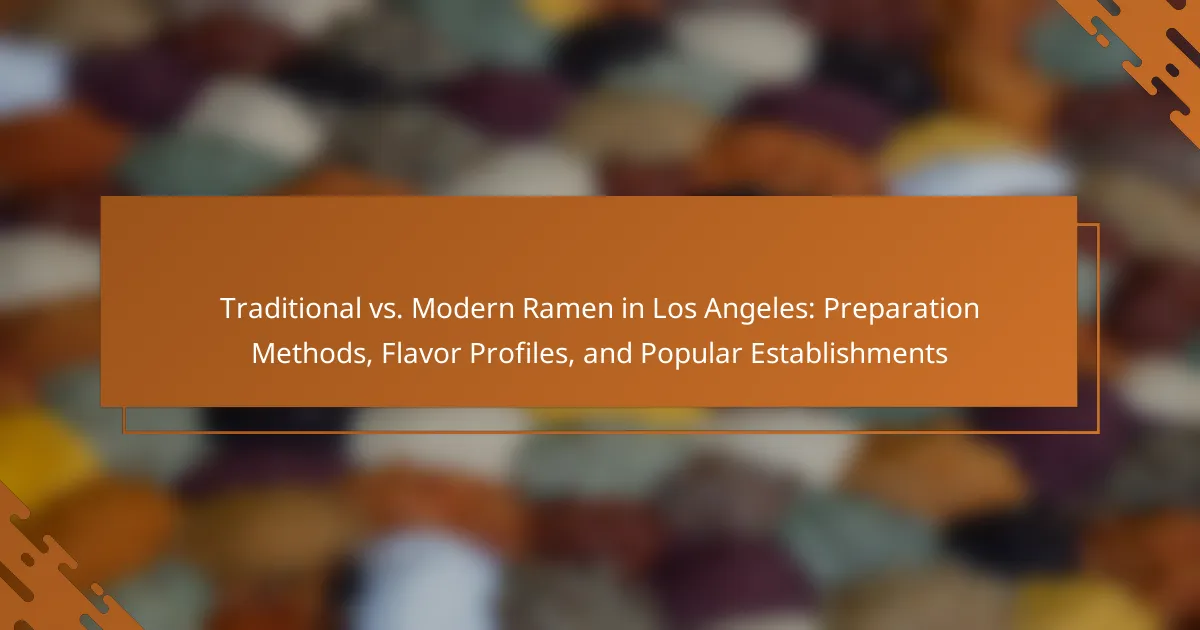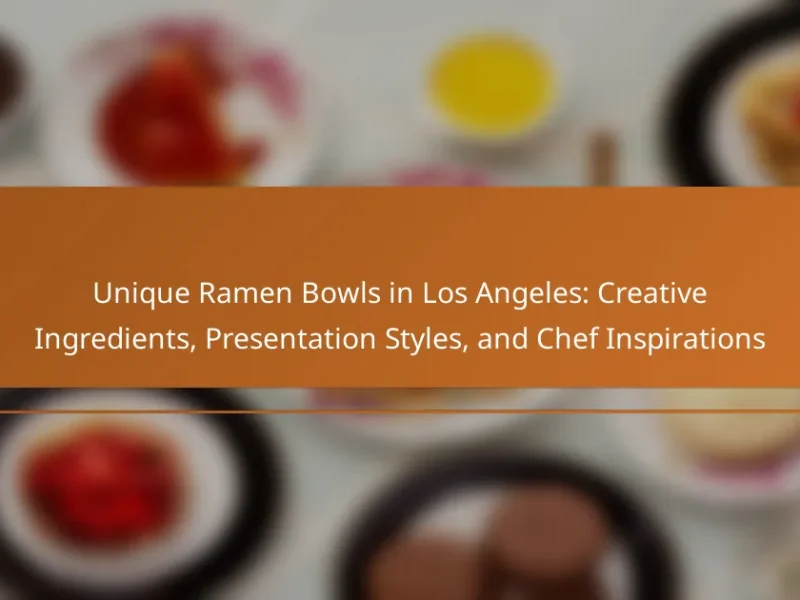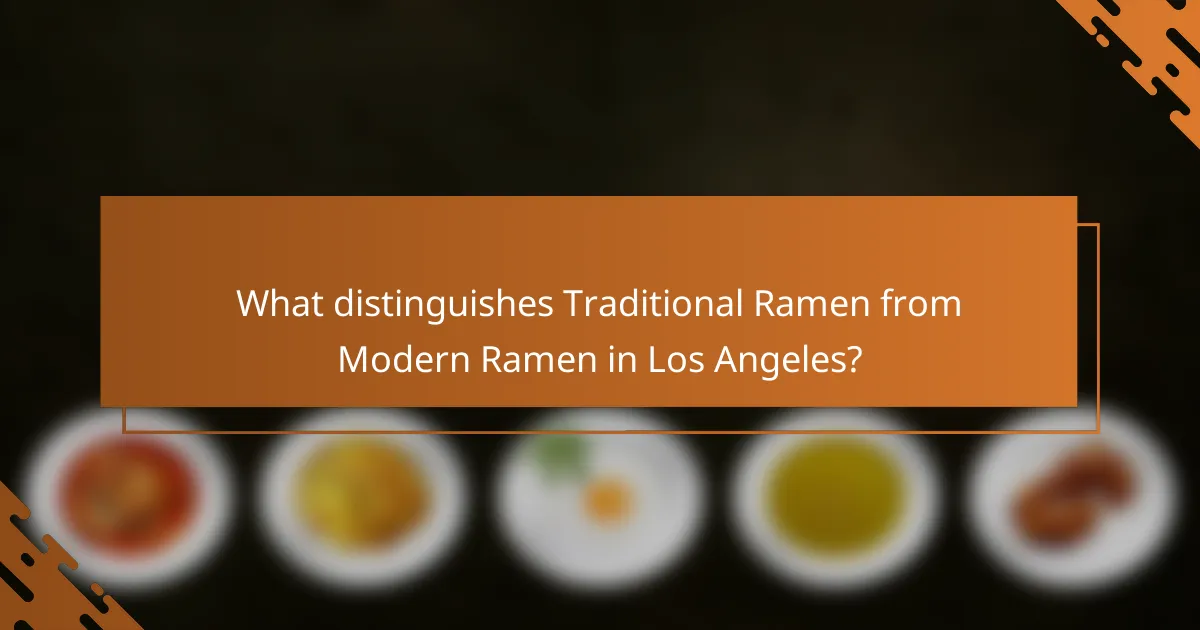
What distinguishes Traditional Ramen from Modern Ramen in Los Angeles?
Traditional Ramen in Los Angeles is characterized by its adherence to authentic Japanese recipes and cooking techniques. It typically features a rich, slow-cooked broth made from pork bones or chicken, along with handmade noodles. The flavor profiles are often deep and complex, focusing on umami. Ingredients like chashu (braised pork), menma (bamboo shoots), and negi (green onions) are commonly used.
In contrast, Modern Ramen often incorporates innovative ingredients and fusion elements. It may use unconventional broths, such as seafood or vegetarian options. Additionally, modern establishments frequently experiment with toppings, including unusual proteins or gourmet garnishes. This variety caters to diverse palates and dietary preferences.
The distinction is evident in the dining experience as well. Traditional Ramen shops tend to maintain a minimalist aesthetic, reflecting Japanese culture. Modern Ramen restaurants often provide a vibrant atmosphere, appealing to a broader customer base. This evolution reflects the culinary landscape of Los Angeles, where tradition meets creativity.
How do preparation methods differ between Traditional and Modern Ramen?
Traditional ramen preparation methods typically involve long-simmered broths made from pork bones, chicken, or seafood. This slow cooking process can take several hours to extract deep flavors. Traditional ramen also emphasizes handmade noodles, which are often made fresh daily. In contrast, modern ramen preparation may utilize quicker brewing techniques and pre-made broths to expedite service. Modern establishments may also incorporate a variety of international ingredients and flavors. For example, fusion toppings like avocado or cheese are common in modern interpretations. Overall, traditional methods focus on authenticity and time-honored techniques, while modern methods prioritize speed and innovation.
What are the key ingredients in Traditional Ramen preparation?
The key ingredients in traditional ramen preparation include ramen noodles, broth, tare, and toppings. Ramen noodles are typically made from wheat flour, water, salt, and kansui, an alkaline mineral water. The broth is commonly a rich combination of pork bones, chicken, and vegetables, simmered for hours to extract deep flavors. Tare is a concentrated seasoning mixture, often made from soy sauce or miso, that enhances the broth’s taste. Common toppings include sliced chashu (braised pork), green onions, nori (seaweed), and menma (bamboo shoots). These ingredients create the authentic flavors associated with traditional ramen dishes.
What are the innovative techniques used in Modern Ramen preparation?
Innovative techniques in modern ramen preparation include sous-vide cooking, fermentation, and molecular gastronomy. Sous-vide allows for precise temperature control, enhancing broth flavors. Fermentation techniques create unique umami profiles in toppings like miso or kimchi. Molecular gastronomy incorporates elements like foam or gels, transforming traditional textures. Additionally, multi-day broth preparation deepens flavor complexity. Advanced noodle-making methods, such as using high-gluten flour, improve texture. These techniques reflect a blend of tradition and modern culinary science, elevating ramen to new gastronomic heights.
What are the unique flavor profiles of Traditional and Modern Ramen?
Traditional ramen features a deep, umami-rich flavor profile. This is primarily achieved through long-simmered broths made from pork bones, chicken, or seafood. Soy sauce and miso are common seasonings, adding saltiness and depth. Toppings like sliced pork, green onions, and nori enhance the overall taste experience.
Modern ramen often incorporates innovative flavors and ingredients. Broths may include non-traditional elements like truffle oil or spicy miso. Chefs experiment with toppings such as corn, cheese, or even avocado. This fusion approach creates a diverse range of flavor profiles, appealing to contemporary palates.
In summary, traditional ramen emphasizes classic, rich flavors, while modern ramen explores creative and diverse taste combinations.
How does the broth differ in Traditional Ramen compared to Modern Ramen?
Traditional ramen broth is typically rich and complex, often made through long simmering of pork bones, chicken, and vegetables. This method creates a deep umami flavor profile. In contrast, modern ramen broth may utilize quicker methods and a variety of ingredients, including seafood or plant-based options, resulting in lighter flavors. Traditional broths are often associated with specific regional styles, such as tonkotsu or shoyu. Modern variations can be more experimental, incorporating fusion elements. The use of instant stock bases in modern ramen also contrasts with the meticulous preparation of traditional broths. This difference highlights a shift in culinary techniques and flavor preferences over time.
What role do toppings play in defining the flavor of each type of Ramen?
Toppings significantly influence the flavor of each type of ramen. They add unique tastes and textures that complement the broth. Common toppings include chashu (braised pork), which provides richness. Scallions enhance freshness and a mild onion flavor. Nori (seaweed) adds umami and a salty note. Menma (bamboo shoots) contributes a crunchy texture and slight sweetness. Each topping is chosen to balance the specific flavor profile of the ramen. For example, tonkotsu ramen benefits from fatty chashu, while shoyu ramen pairs well with lighter toppings. The combination of these toppings creates a harmonious and layered flavor experience in each bowl of ramen.
Which establishments in Los Angeles are known for Traditional Ramen?
Tatsu Ramen is known for Traditional Ramen in Los Angeles. It offers a variety of rich broths and homemade noodles. Another establishment is Daikokuya, famous for its tonkotsu ramen. Their broth is simmered for over 20 hours. Tsujita LA is also renowned for its traditional tsukemen. They serve dipping noodles with a flavorful pork broth. These establishments have garnered positive reviews for their authentic flavors. They are frequently recommended by ramen enthusiasts in the area.
What should you expect when dining at a Traditional Ramen restaurant?
When dining at a Traditional Ramen restaurant, you should expect a focus on authentic flavors and techniques. Traditional ramen emphasizes rich, flavorful broth made from pork, chicken, or seafood. The noodles are typically fresh and made in-house, providing a chewy texture. Toppings such as chashu (braised pork), menma (bamboo shoots), and green onions are common.
Expect a simple menu that highlights a few signature dishes. The dining experience often includes a casual atmosphere. Traditional ramen shops may have an open kitchen, allowing diners to see the preparation process. Many establishments prioritize quality ingredients sourced from local suppliers.
The experience may also include the option to customize your bowl, such as adjusting the richness of the broth or adding extra toppings. In Los Angeles, some traditional ramen restaurants follow regional styles from Japan, such as Tonkotsu or Shoyu ramen. Overall, the focus is on delivering an authentic and satisfying bowl of ramen.
How do customer reviews reflect the experience of Traditional Ramen in LA?
Customer reviews reflect the experience of Traditional Ramen in LA by highlighting key aspects like flavor, texture, and authenticity. Many reviews emphasize the rich broth and its complexity, often noting the use of traditional ingredients. Diners frequently comment on the noodles’ chewiness, which is a hallmark of authentic ramen. Reviews also mention the overall dining atmosphere, with many praising the cultural ambiance of ramen shops. Customers often share their experiences with specific dishes, providing insights into popular menu items. The consistency of positive feedback regarding service further enhances the dining experience. Additionally, reviews often compare Traditional Ramen to modern interpretations, showcasing preferences for classic flavors. Overall, customer reviews serve as a valuable reflection of the Traditional Ramen experience in LA.
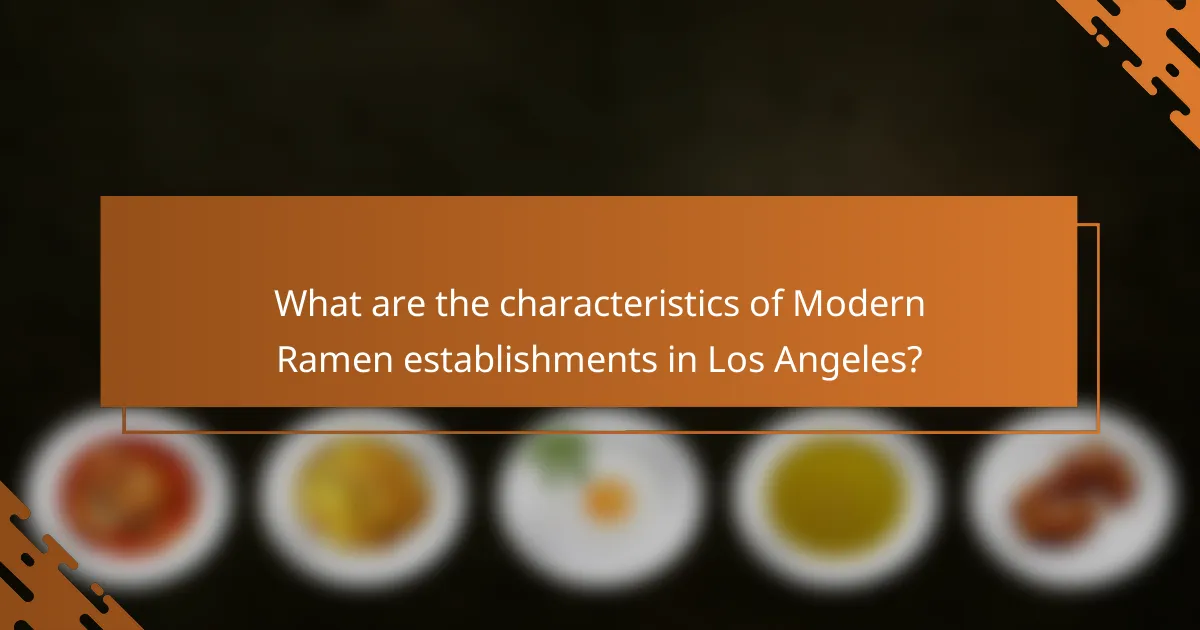
What are the characteristics of Modern Ramen establishments in Los Angeles?
Modern Ramen establishments in Los Angeles are characterized by innovative flavor profiles and unique ingredient combinations. They often feature artisanal broths made from high-quality, locally sourced ingredients. These establishments emphasize customization, allowing customers to choose toppings and spice levels. Many modern ramen shops offer a fusion of traditional Japanese techniques with global influences. Additionally, they often provide a contemporary dining atmosphere with minimalist decor. Some establishments focus on vegan or gluten-free options to cater to diverse dietary preferences. The use of high-quality noodles, often made in-house, is a common trait. Many modern ramen places also engage in social media marketing to attract younger demographics.
How do Modern Ramen restaurants innovate the dining experience?
Modern Ramen restaurants innovate the dining experience through unique flavor combinations and interactive dining concepts. They often introduce non-traditional ingredients, like truffle oil and spicy miso, enhancing classic ramen flavors. Many establishments offer customizable ramen bowls, allowing diners to select broth, noodles, and toppings. This personalization caters to diverse taste preferences and dietary needs.
Additionally, some restaurants incorporate technology, such as tablet ordering systems, to streamline the dining process. This tech integration can improve efficiency and enhance customer engagement. Some modern venues also focus on ambiance, featuring contemporary decor and open kitchen designs to create a dynamic atmosphere.
Furthermore, culinary events, like ramen tastings or chef collaborations, are increasingly popular, fostering community engagement. These innovations reflect a shift towards a more experiential dining approach, appealing to both traditional and new ramen enthusiasts.
What are some popular fusion flavors found in Modern Ramen?
Popular fusion flavors in modern ramen include kimchi, curry, and truffle. Kimchi adds a spicy and tangy element to the broth. Curry introduces a rich and aromatic profile. Truffle oil enhances the umami flavor, creating a luxurious experience. Other flavors like miso and cheese are also prevalent. Miso brings depth and complexity to the dish. Cheese adds creaminess and a unique texture. These fusion flavors reflect culinary creativity and innovation in ramen preparation.
How do Modern Ramen establishments incorporate technology in service?
Modern ramen establishments incorporate technology in service through various digital solutions. Many use online ordering systems to streamline the customer experience. These systems allow customers to place orders via apps or websites. Payment processing has also shifted to contactless methods, enhancing convenience. Additionally, some establishments utilize tablets at tables for menu browsing and ordering. This reduces wait times and improves order accuracy. Digital menu boards display real-time updates on specials and availability. Furthermore, loyalty programs often leverage mobile apps to reward repeat customers. These technological advancements cater to the growing demand for efficiency and convenience in dining.
What trends are influencing the Modern Ramen scene in Los Angeles?
The Modern Ramen scene in Los Angeles is influenced by fusion flavors, innovative ingredients, and sustainability practices. Chefs are incorporating local produce and unique spices to create new flavor profiles. Popular toppings now include non-traditional items like avocado and truffle oil. Vegan and gluten-free options are increasingly available to cater to diverse dietary preferences. The use of artisanal noodles has become a trend, enhancing texture and taste. Collaborations with local breweries and food artisans are also on the rise. Social media plays a significant role in promoting these trends, making visually appealing dishes go viral. These factors collectively shape the evolving landscape of ramen in the city.
How are dietary preferences shaping Modern Ramen offerings?
Dietary preferences are significantly influencing modern ramen offerings. Chefs are adapting recipes to cater to vegan, vegetarian, and gluten-free diets. For instance, plant-based broths are increasingly common, replacing traditional meat-based options. Many establishments now offer gluten-free noodles made from alternative grains. This shift reflects a growing consumer demand for healthier and inclusive dining options. Surveys indicate that over 30% of diners prefer plant-based meals. Additionally, some ramen shops are experimenting with low-sodium and organic ingredients. These changes highlight the industry’s response to evolving dietary trends.
What role does social media play in promoting Modern Ramen restaurants?
Social media significantly enhances the visibility of Modern Ramen restaurants. It allows these establishments to showcase their unique dishes and vibrant atmospheres. Platforms like Instagram and TikTok enable restaurants to share visually appealing content. This attracts food enthusiasts and potential customers. User-generated content further amplifies their reach. Customers posting their experiences creates organic promotion. Hashtags related to ramen increase discoverability among niche audiences. Engaging with followers fosters a community around the brand. Statistics show that 54% of social media users use platforms to research food options. This underscores the importance of social media in driving foot traffic to Modern Ramen restaurants.
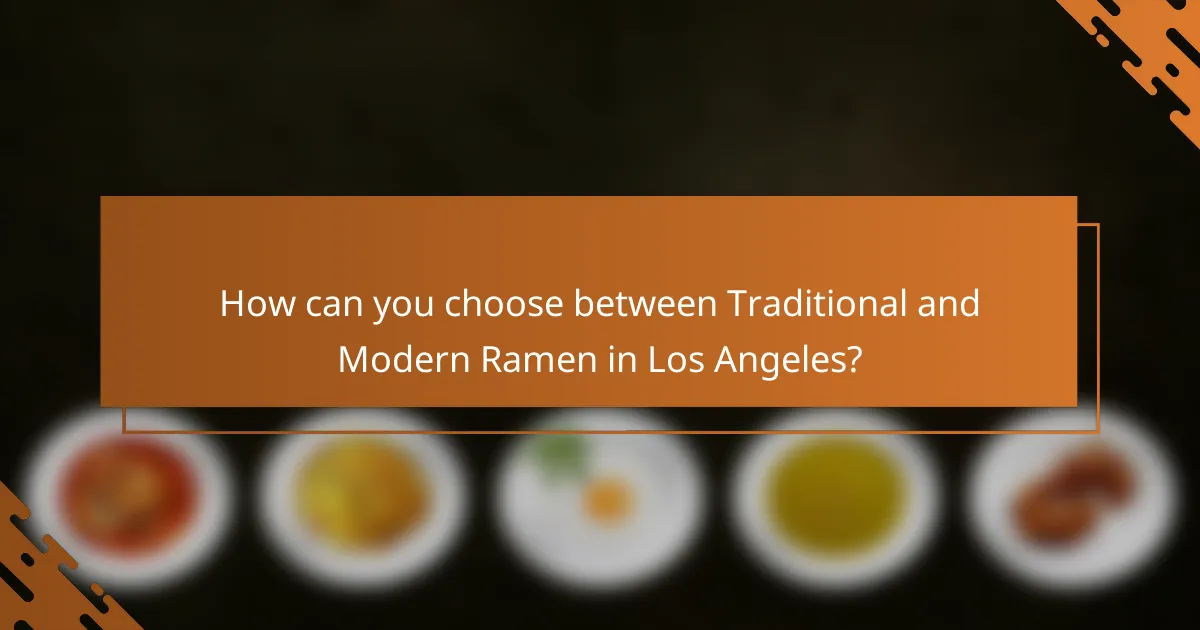
How can you choose between Traditional and Modern Ramen in Los Angeles?
To choose between Traditional and Modern Ramen in Los Angeles, consider the preparation methods and flavor profiles. Traditional ramen typically features a rich, slow-cooked broth made from pork, chicken, or seafood. It often includes classic toppings like chashu, menma, and nori. Modern ramen may incorporate diverse ingredients, innovative flavors, and unique presentations.
For example, modern variations might use unconventional broths, such as vegan options or fusion flavors. Examine the menu of each establishment to identify the styles offered. Popular traditional ramen shops in Los Angeles include Tsujita LA and Daikokuya. For modern interpretations, check out places like Ramen Yamadaya or Silverlake Ramen.
Ultimately, your choice will depend on whether you prefer authentic experiences or adventurous culinary twists. This distinction will guide your dining experience in the vibrant ramen scene of Los Angeles.
What factors should you consider when selecting a Ramen restaurant?
When selecting a Ramen restaurant, consider the broth quality, noodle texture, and overall authenticity. The broth should be rich and flavorful, as it forms the base of the dish. Noodle texture is crucial; they should be fresh and have the right chewiness. Authenticity matters; restaurants that adhere to traditional preparation methods often provide a more genuine experience. Additionally, evaluate the menu variety, as diverse options can enhance your dining experience. Customer reviews and ratings can also provide insight into the restaurant’s reputation and food quality. Lastly, consider the ambiance and service, as these elements contribute to the overall dining experience.
How do personal taste preferences affect your Ramen choice?
Personal taste preferences significantly influence Ramen choices. Individuals often select Ramen based on flavor profiles they enjoy. Options like spicy, savory, or umami cater to different palates. Texture preferences also play a role; some prefer chewy noodles while others like softer varieties. Ingredients such as meat, vegetables, or tofu can sway decisions. Dietary restrictions, like vegetarianism or gluten intolerance, further shape choices. Local establishments in Los Angeles offer diverse options to meet these preferences. Research shows that consumer preferences directly impact restaurant menus and offerings.
What are the best practices for sampling both Traditional and Modern Ramen?
To sample both Traditional and Modern Ramen effectively, focus on distinct preparation styles. Start by visiting establishments known for each type. Traditional Ramen often features a rich, pork-based broth, while Modern Ramen may incorporate innovative ingredients and flavors.
Order small portions or share dishes to experience a variety of flavors. Pay attention to the texture of the noodles, as traditional recipes typically use alkaline noodles, while modern variations may experiment with different textures.
Take note of the garnishes and toppings, which can enhance the overall experience. Traditional Ramen usually includes items like menma and chashu, while modern versions may feature unique toppings like truffle oil or sous-vide eggs.
Consider the ambiance and presentation, as these can influence the tasting experience. Traditional Ramen shops often have a nostalgic feel, while modern spots may emphasize a contemporary aesthetic.
Finally, keep an open mind to new flavors and combinations. This approach allows for a comprehensive understanding of both styles.
What are some must-try dishes in both Traditional and Modern Ramen styles?
Must-try dishes in Traditional Ramen include Tonkotsu Ramen and Shoyu Ramen. Tonkotsu Ramen features a rich pork bone broth, often topped with chashu (braised pork), green onions, and soft-boiled eggs. Shoyu Ramen is characterized by its soy sauce-based broth, typically garnished with nori (seaweed), menma (bamboo shoots), and scallions.
In Modern Ramen, popular dishes include Spicy Miso Ramen and Vegan Ramen. Spicy Miso Ramen combines a miso-based broth with chili oil, often featuring toppings like ground pork and bean sprouts. Vegan Ramen offers a plant-based broth, usually made from vegetables and miso, topped with tofu and seasonal vegetables.
These dishes showcase the diversity and evolution of ramen styles in Los Angeles.
What signature dishes should you look for in Traditional Ramen spots?
Look for signature dishes like Shoyu Ramen, Tonkotsu Ramen, and Miso Ramen in Traditional Ramen spots. Shoyu Ramen features a soy sauce-based broth, often with a clear, rich flavor. Tonkotsu Ramen has a creamy, pork bone broth that is hearty and umami-rich. Miso Ramen incorporates fermented soybean paste, providing a unique depth of flavor. Each dish typically includes toppings like chashu pork, green onions, and soft-boiled eggs. These dishes represent the core styles of traditional ramen, showcasing authentic preparation methods. Traditional ramen shops often emphasize these signature dishes to highlight their culinary heritage.
Which innovative dishes stand out in Modern Ramen restaurants?
Innovative dishes that stand out in Modern Ramen restaurants include truffle oil ramen, vegan ramen, and spicy miso ramen. Truffle oil ramen features a rich, aromatic flavor profile that elevates traditional broth. Vegan ramen utilizes plant-based ingredients, appealing to a broader audience. Spicy miso ramen incorporates bold, spicy flavors, enhancing the overall taste experience. These dishes reflect the evolving culinary creativity in ramen preparation. Modern Ramen restaurants often experiment with unconventional toppings and fusion elements, further distinguishing their offerings.
How can you enhance your Ramen dining experience in Los Angeles?
To enhance your Ramen dining experience in Los Angeles, explore various Ramen styles available in the city. Los Angeles boasts traditional Shoyu, Miso, and Tonkotsu Ramen, each with distinct flavor profiles. Pair your Ramen with authentic toppings like chashu, soft-boiled eggs, and nori for a richer taste. Visit popular establishments known for their unique recipes, such as Tsujita LA, which specializes in Tsukemen, a dipping noodle dish. Consider trying Ramen during off-peak hours to enjoy a quieter atmosphere and better service. Engage with staff to learn about their recommendations and specials. Participate in Ramen tasting events or pop-ups to discover new flavors and techniques.
The main entity of the article is Ramen, specifically focusing on the distinctions between Traditional and Modern Ramen in Los Angeles. The article examines preparation methods, highlighting the authentic techniques of Traditional Ramen, such as long-simmered broths and handmade noodles, in contrast to the innovative approaches of Modern Ramen, which incorporate fusion flavors and quicker preparation methods. It also explores the unique flavor profiles and key ingredients of each style, as well as popular establishments known for their offerings. Additionally, the article discusses customer reviews, dining experiences, and trends shaping the ramen scene in Los Angeles.
